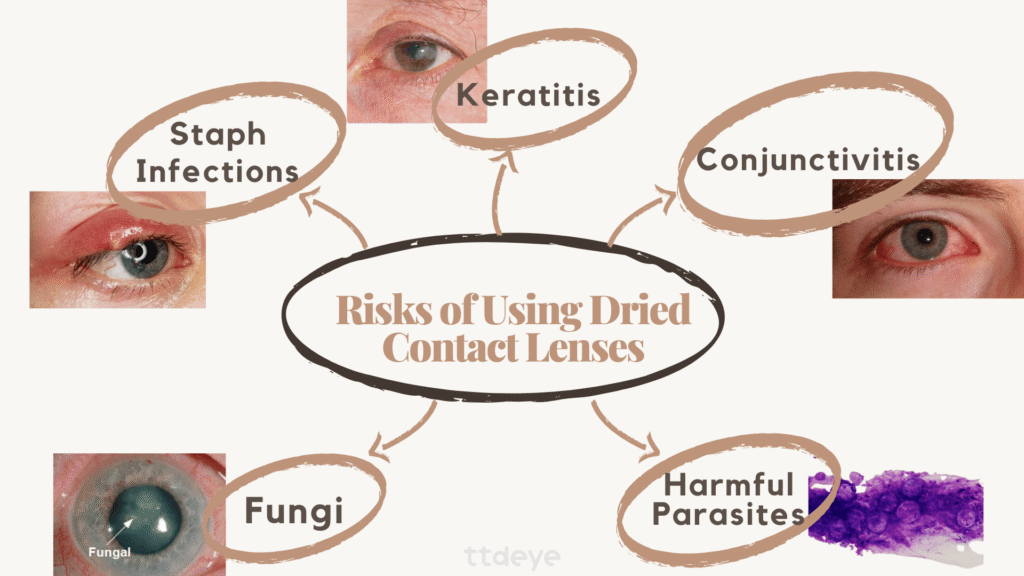
Contact lenses offer a convenient way to improve vision, but it’s crucial to prioritize eye health by following proper care practices. One common question that arises is whether contact lenses can be reused. While the temptation to save money or time might exist, reusing disposable contact lenses is strongly discouraged by eye care professionals.
This article will delve into the potential risks and dangers associated with reusing contact lenses, emphasizing the importance of adhering to single-use guidelines for optimal eye health. We’ll explore the consequences of bacteria buildup, the risk of eye infections, and the specific considerations for daily disposable lenses. By understanding these risks, you can make informed decisions about your contact lens hygiene and protect your precious eyesight.
Risks of Reusing Contact Lenses
Reusing contact lenses, regardless of their type, exposes your eyes to a multitude of potential risks. When you wear contact lenses, they come into contact with various substances like tears, dust, allergens, and even bacteria from your eyelids. These substances can accumulate on the lens surface over time, creating a breeding ground for microorganisms.
Furthermore, reusing lenses prevents them from effectively cleaning and disinfecting between wears. This allows harmful bacteria to thrive and multiply, increasing the risk of eye infections and other complications. Even if you meticulously clean your lenses after each use, it’s impossible to eliminate all traces of bacteria and debris.
Repeatedly exposing your eyes to these contaminants can lead to persistent irritation, discomfort, and even vision impairment. It’s essential to remember that your eyes are delicate organs, and taking shortcuts with contact lens hygiene can have serious consequences.
Eye Infections and Complications
One of the most significant risks associated with reusing contact lenses is the development of eye infections. These infections can range from mild conjunctivitis (pink eye) to severe keratitis, which involves inflammation of the cornea – the clear front part of your eye.
Keratitis can cause pain, redness, blurred vision, and even permanent vision loss if left untreated. Bacteria like Pseudomonas aeruginosa are particularly dangerous as they can thrive in contact lens solutions and cause rapid corneal damage. Other types of infections, such as fungal keratitis, can also occur due to contaminated lenses.
Symptoms of Eye Infections
Be vigilant for any signs of eye infection, including:
- Redness or inflammation
- Pain or discomfort
- Blurred vision
- Sensitivity to light
- Discharge from the eyes
- Feeling like something is in your eye
If you experience any of these symptoms, immediately discontinue contact lens wear and consult an eye doctor. Early diagnosis and treatment are crucial for preventing complications.
Bacteria Buildup
Bacteria naturally exist on our skin and eyelids, and they can easily transfer to contact lenses during wear. When lenses are reused without proper cleaning and disinfection, bacteria have ample opportunity to multiply on the surface.
This buildup of bacteria creates a film that can irritate your eyes, causing redness, itching, and discomfort. Over time, this bacterial contamination can lead to more serious infections as mentioned previously.
Daily Disposable Lenses
Daily disposable contact lenses are designed for single-use only and should be discarded after each wear. They offer the highest level of hygiene because they eliminate the risk of bacteria buildup and cross-contamination associated with reusable lenses.
While daily disposables may seem more expensive upfront, they ultimately save you money in the long run by reducing the risk of eye infections and complications that could require costly medical treatment.
Contact Lens Hygiene
Regardless of the type of contact lenses you wear, maintaining good hygiene practices is essential for protecting your eye health.
Cleaning and Disinfection
Always follow your eye doctor’s instructions regarding lens cleaning and disinfection solutions. Use fresh solution every time you clean your lenses and never reuse old solution.
Handwashing
Thoroughly wash your hands with soap and water before handling your contact lenses. This helps prevent the transfer of bacteria from your hands to your eyes.
Storage Case
Clean and disinfect your lens storage case regularly according to the manufacturer’s instructions. Replace your case every three months to minimize bacterial growth.
Conclusion
Reusing contact lenses, including can you reuse disposable contact lenses, can daily contact lenses be reused, can you reuse one day contact lenses, can i reuse my daily contacts, can i reuse one day contact lenses, can you reuse 1 day contact lenses, can you reuse 1 day contacts, can i reuse one day contacts, and can you re wear daily contacts, poses significant risks to your eye health.
The potential for bacterial buildup, eye infections, and vision complications outweighs any perceived benefits of reusing lenses. Always prioritize your eye health by following single-use guidelines, practicing proper hygiene, and consulting your eye doctor for personalized advice. Remember, your vision is precious – protect it!
